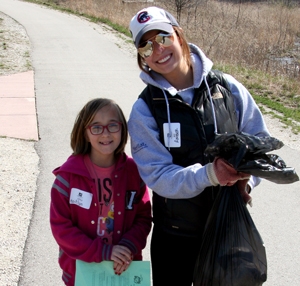
See For Yourself - Our Eco-friendly Facilities
Every choice we make about the form and function of our buildings is made with the environment in mind. From energy sources to recycled materials, Urban Ecology Center facilities provide real life examples of green building practices and management.
Visit us and see all the smart ways you can make your home and business greener.
CRIKT and You
It is the season of showy butterflies, buzzing cicadas, crackling grass hopper wings and CRIKT research. Nope, that is not a typo. CRIKT stands for “Citizens Researching Invertebrate Kritters Together” and this research team at the Urban Ecology Center is leading the nation in its approach to field ecological research. “Invertebrate Kritters” refers to the vast array of animals found in the insect, spider and mite categories. Because invertebrates impact people in a variety of ways: pollinating crops, decimating crops and invoking some of our greatest fears or senses of awe, they have been studied quite a bit over the years. So what sets CRIKT apart? It is WHO is involved and WHERE they work.
See For Yourself - Get Out and Active on an Urban Adventure!
It’s time to explore! Our Urban Adventures programs will have you paddling, pedaling and climbing all summer long. Get into nature, there’s so much life!
Thanks to your support, kids and adults in the city can canoe, bike or climb — often for the first time. What a great way to be introduced to nature!
¡Únese a la conversación!
Varias veces a la semana, escucho nuevas ideas de miembros del Centro, visitantes, y de jóvenes científicos. Cada persona que participa en el Urban Ecology Center tiene experiencias, conocimiento e ideas que compartir, y una de las partes favoritas de mi trabajo es tener la oportunidad de escuchar las ideas de nuestra comunidad.
Como pueden imaginarse unos de mis eventos preferidos son los Foros Comunitarios. Los cuales son reuniones que están abiertas al público, donde la intención es brindar la oportunidad a toda la comunidad de compartir sus opiniones e ideas, y para que también nuestros empleados puedan conectar más con la comunidad y conocer sus intereses.
Join the Conversation!
Several times a week, I get to hear new ideas — from members, visitors or Young Scientists. Each person who participates at the Urban Ecology Center has experiences, knowledge and ideas to share, and one of my favorite parts of my job is getting the chance to hear the ideas from our community.
As you can imagine, some of my favorite events at the Center are our Community Forums—meetings that are open to the public, whose intent is to give our whole community the opportunity to share their opinions and ideas, and for our staff to have the chance to connect with community members and listen to these opinions and ideas.
Plan Your Next Event at Our Two Newest Branches!
Baby showers and birthday parties and weddings – oh my! When the education classes wrap up and our public programs are done, the second life of our classrooms and branches emerges. Retirement parties, memorial celebrations, bridal showers, company retreats and more! Our spaces get used all over again – a repurposing of space if you will – with our facility rental program.
Ten Years of Art Exhibits at the Urban Ecology Center
As our art exhibits enter their tenth year, Sally Duback, one of the founding members of our arts committee offers this reflection about the beginning and growth of the program.
Ten years ago, UEC board member Danni Gendelman convinced the board that it would be a good idea to host nature-related art exhibitions in the community room. In order to make this happen, she pulled together a small committee of Milwaukee area artists/arts professionals Barbara Manger, Sally Duback and Leon Travanti; and discussions began among them about how this could work.
Share our Secret and Win a Secret Adventure!
It was the best “wild ice” for skating that I have found in years. A vast expanse of smooth-as-glass clear ice made not by a Zamboni, but by Mother Nature herself. And perhaps the biggest surprise of all? This “secret gem” wasn’t some hidden lake up state, but it was right here, in the shadow of the US Bank building downtown. I’ve been here over 20 years now and I still keep finding the unexpected. This is why I LOVE living in Milwaukee.
You Feel Mighty Free and Easy and Comfortable on a Raft
Last summer the Urban Ecology Center held its first Engineering for Kids Summer Camp for third and fourth graders. The entire experience at this camp completely exceeded my expectations. The campers built a raft with their own hands out of recycled wood, inner tubes, ropes and milk jugs and on their last day of camp they embarked on a big adventure - gliding their raft down the Menomonee River.
I felt intimately connected to this project as it reminded me of my childhood. My friends and I used to build rafts with driftwood in the Alagón River Reservoir, Spain. It was a passion I could share with my campers.
See for Yourself: Signs of Life - Habitat Restoration
Our habitat restoration efforts and research projects really go hand-in-hand. As we restore the land, we discover more and more mammals, birds, insects and amphibians using our parks. Our studies also help to determine the number of native plant species we’ve added that have “taken root” and are continuing to grow. Here are just a few highlights you can find.
Copyright © 2023 The Urban Ecology Center












